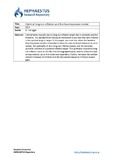| dc.contributor.author | Pontiggia, Dario | |
| dc.date.accessioned | 2015-12-09T12:32:30Z | |
| dc.date.available | 2015-12-09T12:32:30Z | |
| dc.date.issued | 2012-08 | |
| dc.identifier.issn | 0164-0704 | |
| dc.identifier.uri | http://hdl.handle.net/11728/6462 | |
| dc.description.abstract | Central banks typically have a long-run inflation target that is modestly positive. However, the standard New Keynesian framework prescribes that zero inflation is the optimal longrun target. In this paper, we show that when the baseline New Keynesian model is extended to allow for rule-of-thumb behavior by price setters, the optimality of zero long-run inflation ceases, and the monetary authority commits to a positive inflation target. The optimality of positive long-run inflation turns on the fact that the aggregatesupply relation does not imply an equivalence, up to first-order and regardless of policy, between the welfare-relevant measure of inflation and the discounted sequence of future output gaps. | en_UK |
| dc.language.iso | en | en_UK |
| dc.publisher | Elsevier | en_UK |
| dc.relation.ispartofseries | Journal of Macroeconomics;34 | |
| dc.rights | © 2012 Elsevier Inc. | en_UK |
| dc.rights.uri | http://creativecommons.org/licenses/by-nc-nd/4.0/ | en_UK |
| dc.subject | Optimal monetary policy | en_UK |
| dc.subject | Inflation persistence | en_UK |
| dc.subject | Phillips curve | en_UK |
| dc.title | Optimal long-run inflation and the New Keynesian model | en_UK |
| dc.type | Article | en_UK |
| dc.doi | 10.1016/j.jmacro.2012.07.003 | |


